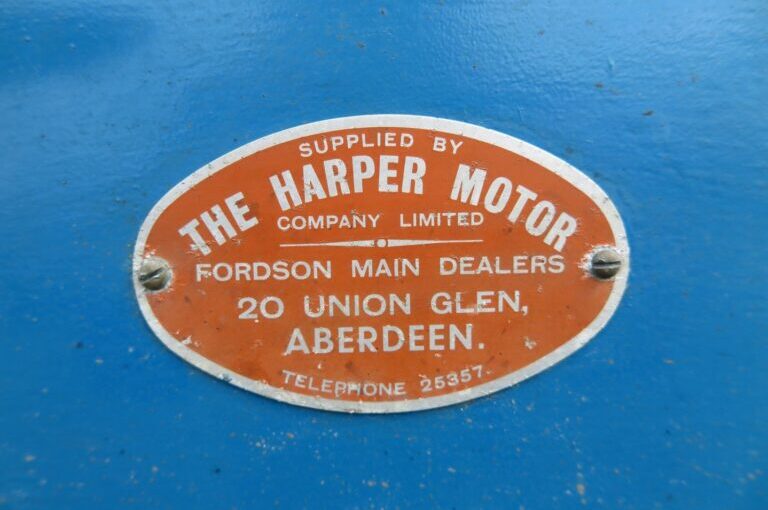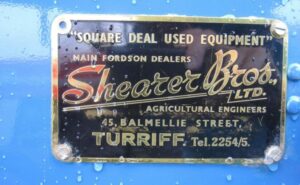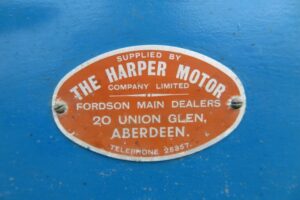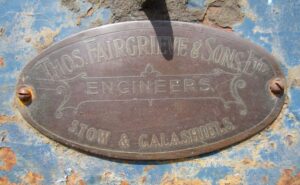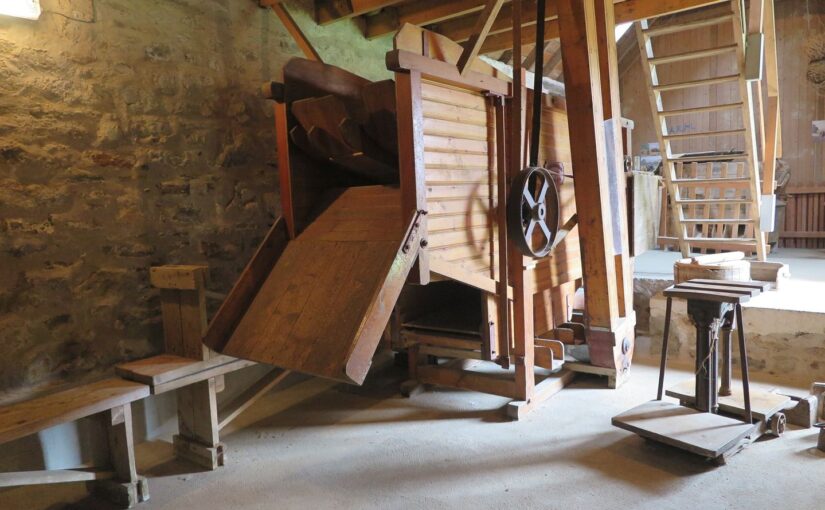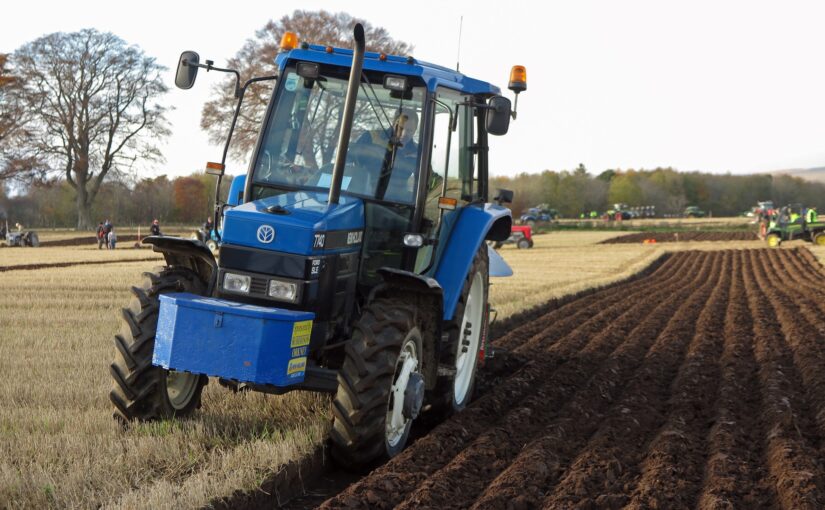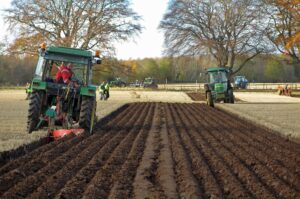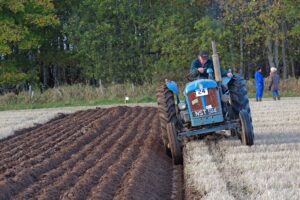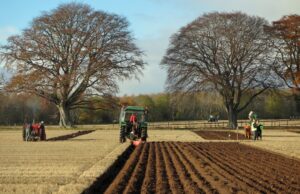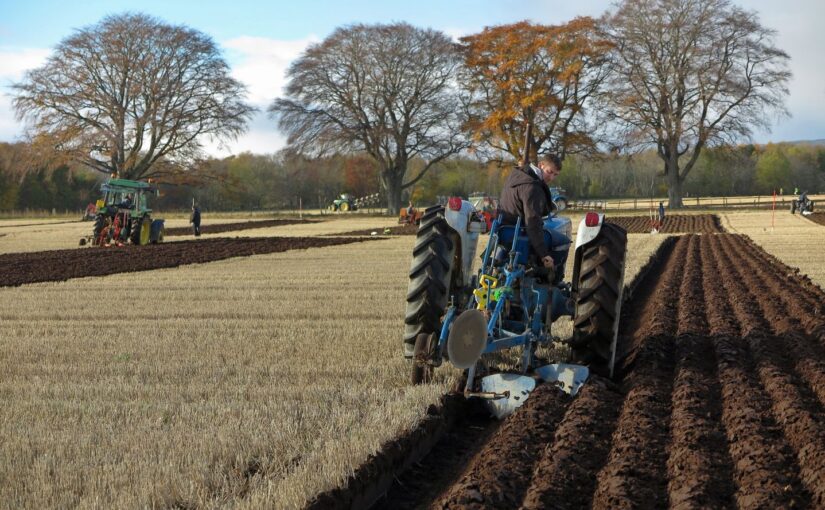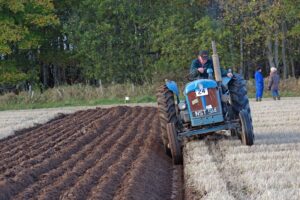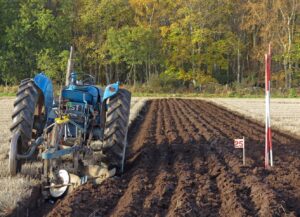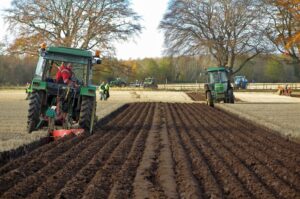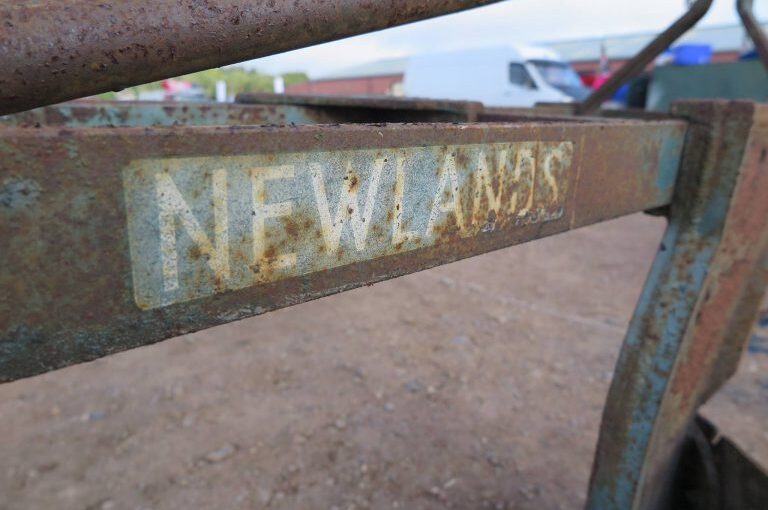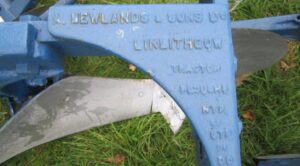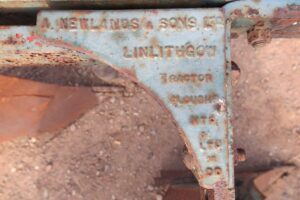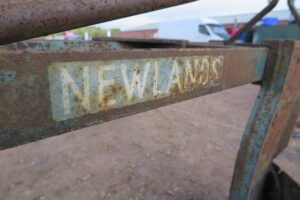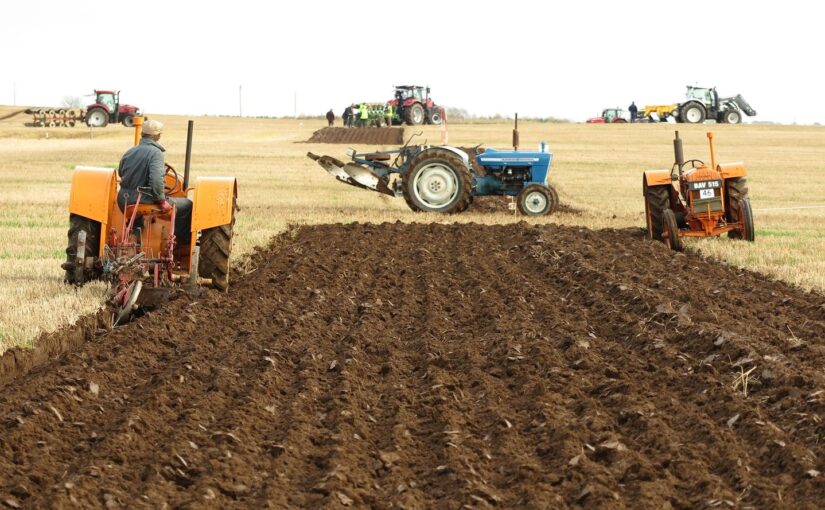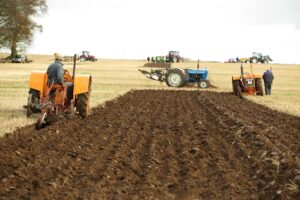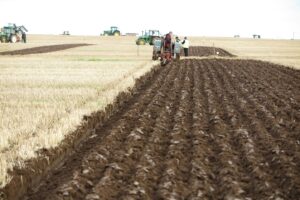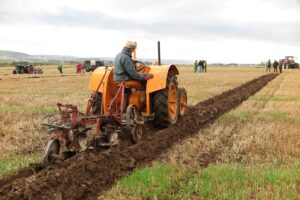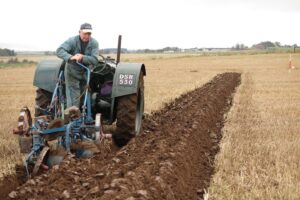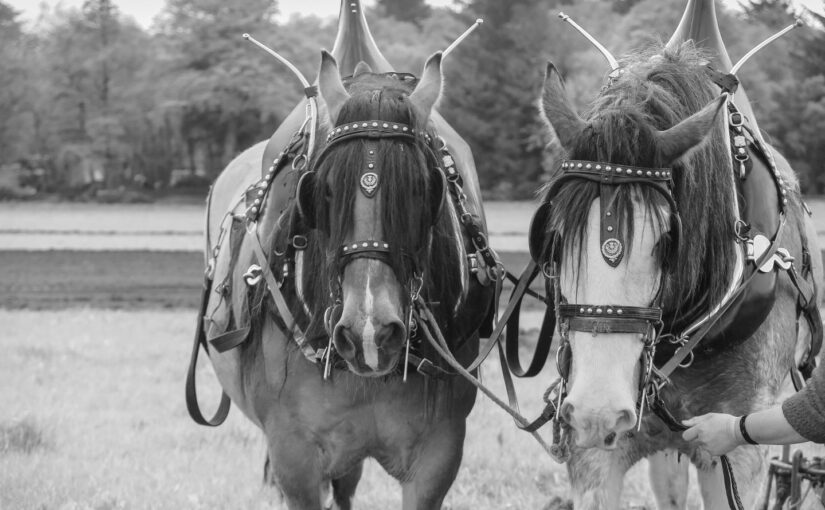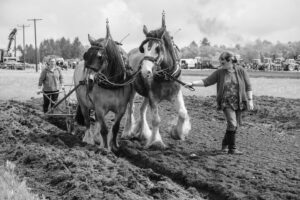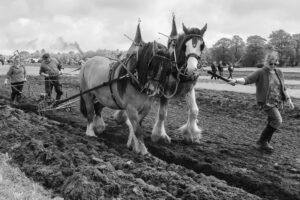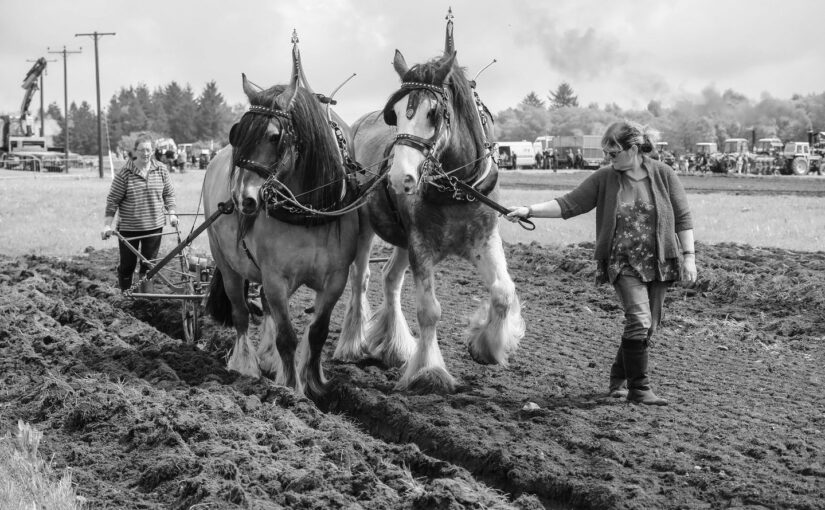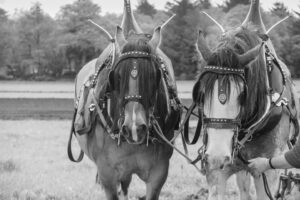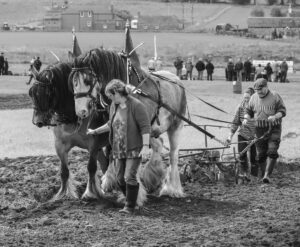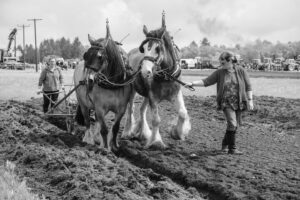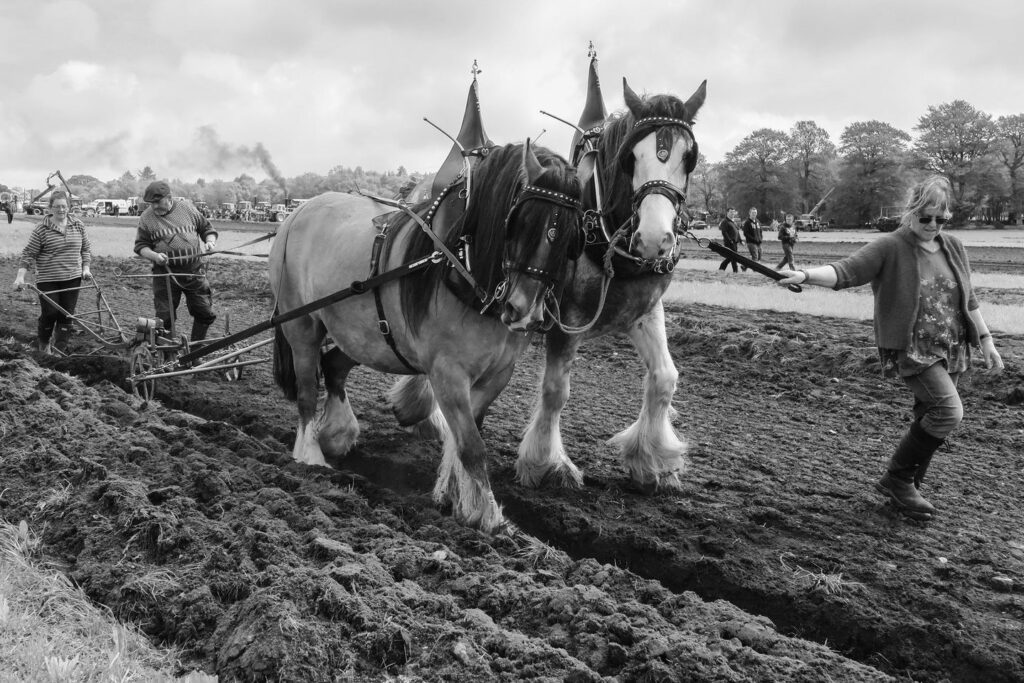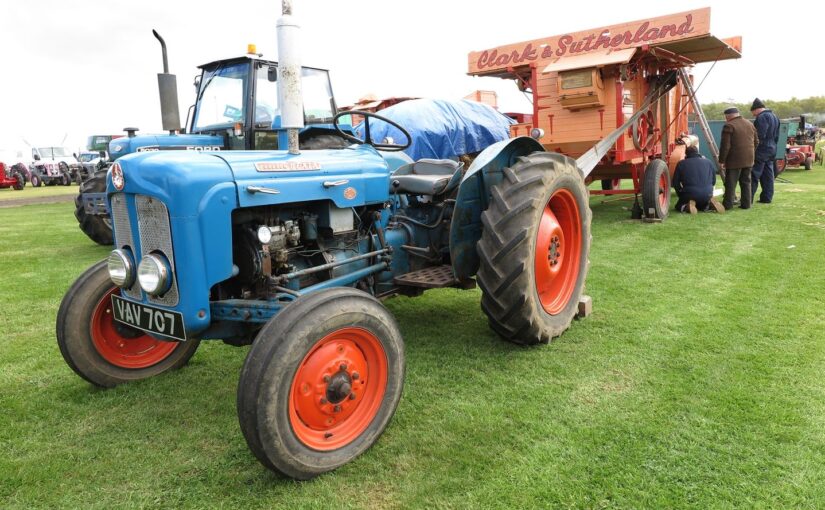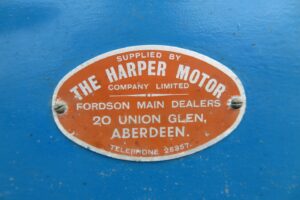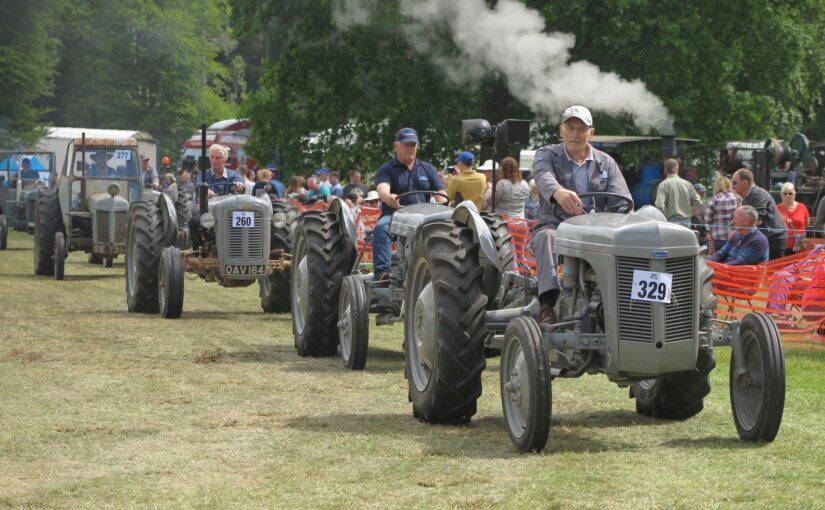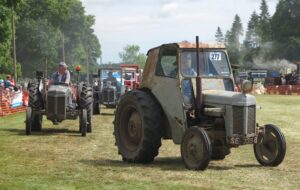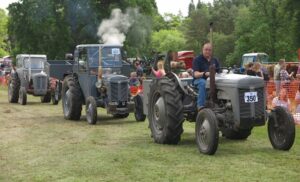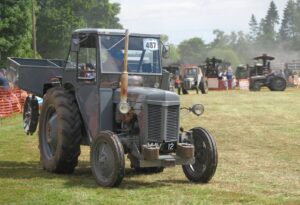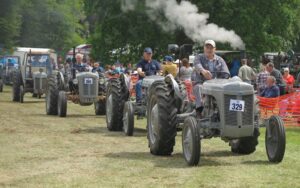From the mid nineteenth century a number of champion ploughing matches were held in Scotland. These were especially noted in the north-east. They were open to ploughmen who had won awards at earlier matches – hence the matches were matches of champions pitting their skills against one another.
By the 1900s some of these matches were large affairs and were well-attended. The Lower Deeside Champion Ploughing Match was set up in 1910 and continued for a number of decades. It was a large match, with competitors sometimes coming from far afield to compete against well-known ploughmen, to produce high-quality ploughing. Accounts of the match were usually printed in the Aberdeen Press and Journal.
Accounts of the champion ploughing matches in the mid 1930s reveal their competitiveness and what they were like. They note the place and date of the match; the weather and soil conditions; the number of entries and ploughmen; classes; the names of the judges; the quality of the work executed; the names of the winners and their prizes; the minor classes and their award winners. By the 1930s the number of minor classes was very extensive. Some were subjective and included the class for the best looking ploughman.
The following are accounts of some of the champion ploughing matches in north-west Scotland in the mid 1930s:
“Deeside match honours
W. Gilbert, Fetternear, leads
Horses from Royal farm win
Twenty-five crack ploughman took the field at Tarland to compete for the handsome prizes offered by the Deeside Champion Ploughing Association, and the work all over was of a high standard of excellence. Owing to the uncertainty of the weather conditions, eleven competitors failed to turn up.
The field was fine, equal land placed at the disposal of the association by Mr G. McAllan, Aberdeen Arms Hotel, Tarland, and the ground was the best the judges ever experienced for such an event. The land was very free, although a little wet in some parts after the recent heavy rains.
The committee were early at work getting things in order for the match, the members present including Messrs Michie, Carnbethie, Lumphanan, chairman; Robert Kirk, Home Fram, Glen Tanar, vice-chairman; W. Webster, Dudston; John Smith, Norwood; James Morrice, manager, Huntly Fram, Aboyne; Jas McConnach, Deerhillock; Duncan Reid, Craskens; Alex McCrombie, Hillocks; John McCaw, manager, Douneside; Alex Shepherd, Wardfold; and C. Leslie, Lumphanan; while the judges were Messrs Alex Dunn, Wester Leochel; Archibald Middleton, Aberdeen; Jas Allan, Begsley; and Brown, Lauchentilly, Dunecht.
Work of high standard
Mr Alexander Middleton, East Mains, Aboyne, secretary, had everything in first-rate order, and the competition was in every respect a great success. When the match started the weather was dull, and later a thick fog settled down, but the match finished without a threatened rainfall. The field was visited by a large number of farmers and farm workers, who showed much interest in the fine work of the ploughmen.
An interesting event was the customary competition for horses and harness and decoration, and the display of horses was a splendid sight in itself. It was an extra fine show, with a number of outstanding geldings.
The cup for most points deservedly went to the King’s horses from Abergeldie Mains-a pair of handsome animals, beautifully decorated, which evoked much admiration. The ploughman who worked the horses was Mr Wm McGregor, Abergeldie.
Ploughing trophies
Many well-known ploughing champions took the field. Mr Wm Gilbert, from Fetternear, carried off the cup gifted by Lady MacRobert of Douneside, also £5 by the associations. His names will be inscribed also on Lord Glentaner’s challenge quaich, which has to be won twice in succession or three times altogether. His well-turned in rig, equal sizing and uniform furrows were faultlessly done. Mr Gilbert is no strange to ploughing honours on Deeside. He was first and twice second at Aboyne.
The runner up was R. Beattie, Lenton, who had his name on in 1931. Last year’s winner was not so lucky for a rig and had to take seventh place.
The first prize-winner failed to get a place in the feering or finish, but took the prize for the straightest furrows. The feering and finish were won by Mr George Beattie, who secured a beautiful teapot, gifted by Mrs A. Strachan, Deeside Omnibus Service.
The awards were:-
Ploughing-1 Wm Gilbert, Fetternear; 2. Geo. Beattie; 3. Wm Beverley; 4. John Thompson, Drumallochie; 5. Robert Moir, Drum; 6. Robt Allan, Echt; 7. Alex Shepherd; 8. Alex Malcolm, Finzean; 9. Jas Morrice, Lumphanan; 10. Jas Gilbert, Glassel; 11. Geo. Malcolm, do.; 12. Joseph Duncan, Lumphanan; 13. Jas Fraser, Lumphanan; 14. Geo Lyon, Kintore; 15. John Smith, Towie. Feering-1. Jas Morrice, Lumphanan; 2. Archie Coupland, Birse. Finish-1. G. Beattie; 2. Joseph Duncan. Straightest furrows-W. Gilbert; oldest ploughman-Alex Shepherd.
Harness-1 (and Reith and Anderson Cup for combined) Wm McGregor, Abergeldie; 2. Wm Catto, Blackmill; 3. Jas Merchant, Dubston, Birse; 4. Alex Irvine, Tillypronie. Grooming-1. Blackmill; 2. Wm McGregor; 3. J. Merchant; 4. Alex Irvine. Decorations-1 Wm McGregor; 2. Wm Catto; 3. Alex Irvine. Combined-1. Wm McGregor; 2. Wm Catto; 3. Alex Irvine.
Mr R. Kirk presided at the dinner held in the Aberdeen Arms Hotel, and the customary toasts were honoured. Replying to the toast of “The Secretary”, proposed by Mr Gillies, Glen Tanar, Mr Middleton expressed the association’s indebtedness for the generous support given by the leading people and friends and neighbours in the district. He gave “The Donors”, Mr A. L. Stronach replying. Mr Duncan Reid, thanked the farmers who lent horses, also Mr P. Strachan, Easttown. A social programme was given by Messrs Stronach, Gillies, Kirk, J. B. Anderson, and Coull.” (Aberdeen press and journal, 7 March 1933)
“Huntly Champion Match
W. Gilbert, Fetternear, wins H.S. Medal.
Record crowd at Westerton.
The annual champion ploughing match, under the auspices of Huntly Ploughing Association, was held at Westerton, Huntly, on a most suitable field on Deveronside, granted by Messrs Fraser and Fawns, tenants. The weather was fine, and there was a large entry of competitors from north and south. Spectators also came from all parts, and the attendance was a record.
Added interest was given to the proceedings by a tractor competition, which received much attention and was eagerly watched. All over better work was never seen at a match in Strathbogie, and the judges had no light task in making their awards. The arrangements, as usual, made by Mr Alex Dempster, Auchomer, were in all respects excellent.
The judges were:-Messrs Alex Shand, Muldrane, Keith; Peter William, 69 High Street, Aberlour; Alex Conn, Nether Blackhead, Inverurie; and F. Milne, Nittansghead, New Pitsligo.
William Gilbert, Fetternear, headed a great champion class, and won the Highland Society medal for the best ploughed ridge on the field.
Awards:-Champions-1. W. Gilbert, Moss-side, Fetternear; 2. Alex Clark, Home farm, Aberlour; 3. Wm Mowat, Dams of Craigie, Whitecairns; 4. Wm Barclay, Cowfords, Banff; 5. Geo. Duncan, Westside, Portsoy; 6. James Petrie, Costlyburn, Kinnoir; 7. Roy Duthie, Aulton, Insch; 8. Wm McWilliam, Woodside, Rothiemay; 9. Alex Bremner, Cairnhill, Huntly; 10. John Gilbert, Braeside, Culsalmond; 11. Oswald Shand, Millhill, Marnoch; 12. Wm Beaverley, Haughton Arms, Alford; Jas. McIrvine, Rothmaise, Insch. Feering-1. Wm Mowat, Dams of Craigie; 2. W. Gilbert, Moss-side. Finish-1. Roy Duthie, Aulton, Insch; 2. Wm Mowat. Feering and finish combined-Wm Mowat.
From Cairnbowrrow
Shortboards-1. W. Matthew, Cairnborrow, Glass; 2. G. Wink, Bogforth, Glass; 3. Jas Simpson, Comalegy, Drumblade; 4. Wm Horne, Ladyleys, Oldmeldrum; 5. Alvin Milne, Fordalehouse, Oldmeldrum; 6. Jas Duncan, Kitchen Park, Keith; 7. Kohn McRitchie, Gibston, Huntly; 8. A;ex Anderson, Crookmore, Alford; 9. Robert Horne, Ladyleys, Oldmeldrum; 10. William Forsyth, Mains of Tillyangus, Clatt; 11. G. A. Watt, Cullyknowes, Keith; 12. Andrew Petrie, Drumdollo, Forgue; 13. W. Dawson, Whinbrae, by Huntly; 14. J. Brown, Newbigging, Leslie, Feering-1. J. Brown, Newbigging; 2. Alex Anderson, Crookmore. Finish-1. Wm Matthew, Cairnborrow; 2. Alex Anderson. Feering and finish combined-Wm Matthew.
Best ploughed ridge on field and Highland Society medal-Wm Gilbert, Fetternear; straightest furrows-W. Mowat, Dams of Craigie.
Best looking ploughman-1. John McRitchie, Gibston, Huntly; 2. G. McRitchie, Foot of Hill, Gartly. Ploughman with largest family-Wm McWilliam, Woodside, Rothiemay. Ploughman with youngest child-Wm McWilliam, Woodside, Rothiemay. Oldest ploughman-Wm Beverley, Alford.
Best matched pair-George Wink, Bogforth, Glass.
Tractor ploughing
Tractor ploughing-1. Harper Motor Company, Aberdeen; 2. Alex Dufton, Corse, Kinnoir; 3. David Morren, Dunbennan, Huntly. Best ploughed ridge with Fordson-Harper Motor Company, Aberdeen. Feering-Harper Motor Company, Aberdeen. Finish-Harper Motor Company, Aberdeen. Best ploughed ridge with Ransome-Harper Motor Company, Aberdeen.
Farmer giving most assistance with horses-Mr Chisholm, Gibston, Huntly.
Neatest ends-G. Donald, Deveron Street, Huntly.
Horses coming longest distance-George Duncan, Westside, Portsoy.” (Aberdeen press and journal, 16 January 1934)
“Lower Deeside
Championship to Banff competitor
The twenty-fifth annual Lower Deeside champion ploughing match took place on Saturday at Mr Taylor’s farm of Inchgarth, West Cults. The field was specially suitable for the match, it being level, alluvial land with no stones.
The ploughmen were seriously handicapped throughout the day by driving showers of biting snow, but fortunately between the showers they could make good progress, and they stuck bravely to their task. The judges also had to encounter a heavy shower of snow towards the close, which added to their difficulties in coming to a decision, as so many had meritorious work.
The match is confined to champion ploughmen, of whom forty were present, many of them from far distances-Banffshire, Alford, Oldmeldrum, Ellon, Hatton, Crimond, Fordoun, Glenkindle, Fyvie and Strichen.
The judges were: Mr George Oliphant, Cabra, Mintlaw; Mr John Peters, Backhill, Dunecht; and Mr William Beverley, Haughton Arms, Alford. The committee had everything in splendid working order notwithstanding the rather adverse weather, the chief responsibility falling on the secretary, Mr Charles Miller (Bruce and Co.), Aberdeen; the treasurer, Mr F. T. Garden, ex-banker; and the chairman, Mr Joseph Monro, Mains of Balfour. After the match the committee and judges were entertained at Inchgarth Farm, where the entertainers were heartily thanked, as well as the judges, those who had lent horses, and the donors of prizes, more especially the donor of the solid silver cup for the first prizeman, which was given by Mr W. D. Findlay, Northern Hotel, Kittybrewster. The cup was gained by the well-known Banffshire ploughman, William Barclay, Cowford, Banff, who had also the best finish and the best feering and finish combined.
The winners
The following is the prize list:
1. W. Barclay, Cowford, Banff; 2. C. Reid, Bankhead, Auchinblae; 3. J. H. Taylor, Clayfords, Strichen; 4. A. Gray, Easterton, Auchleuchries; 5. R. Allan, Finnercy, Echt; 6. Alex Shepherd, Wardford, Coull; 7. J. Duncan, Westside, Portsoy; 8. P. Lyon, Leschangie, Kenmay; 9. W. Mowatt, Dams of Criggie; 10. Smith, Drumlegair, Fordoun; 11. A. Moir, Moss-side, Drum; 12. A. Mitchell, Milton, Murtle; 13. T. Fraser, South Ardiffery, Hatton; 14. J. McIrvine, Mains of Rothmaise, Insch; 15. J. Brown, Kirkton of Forbes, Alford; 16. J. Duncan, North Mains, Auchenhove; 17. H. Buchan, Kintowlie, Blairs; 18. J. Thomson, Drumallochie, Glenkindie; 19. J. Cockie, Greenferns, Newhills; 20. J. Shand, Forresterhill, Oldmeldrum.
Feering in hollow, A. Gray; feering in flat, W. Mowatt; finish-1. W. Barclay; 2. R. Allan; feering and finish combined, W. Barclay; straightest furrows, R. Allan; eldest ploughman, A. Shepherd.” (Aberdeen press and journal, 4 February 1935)
